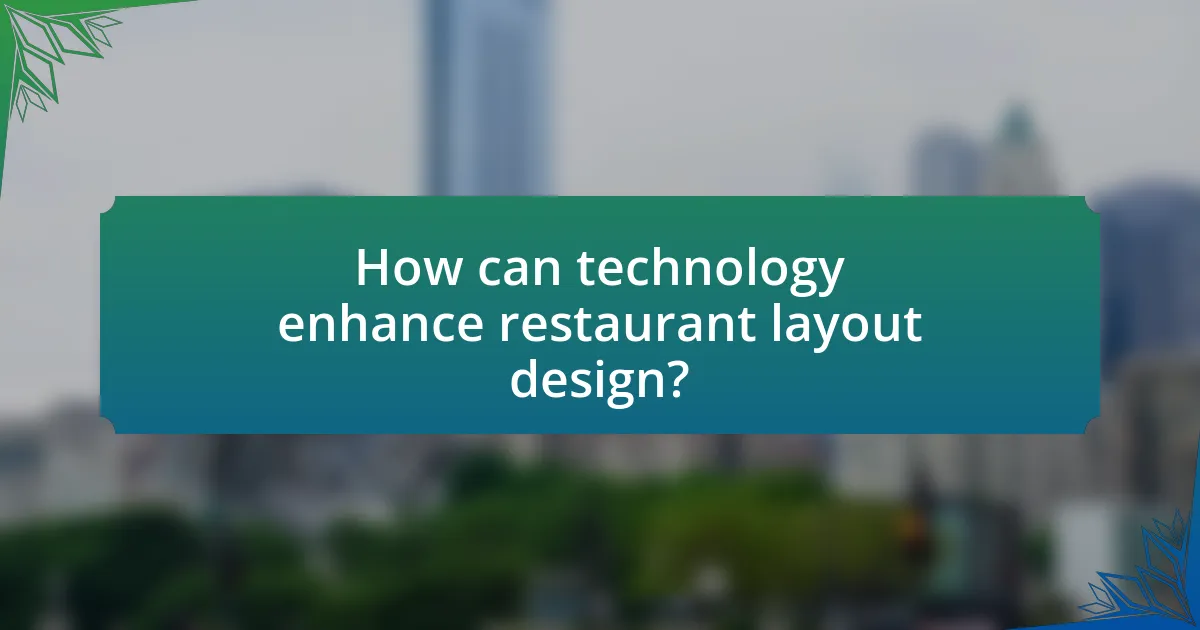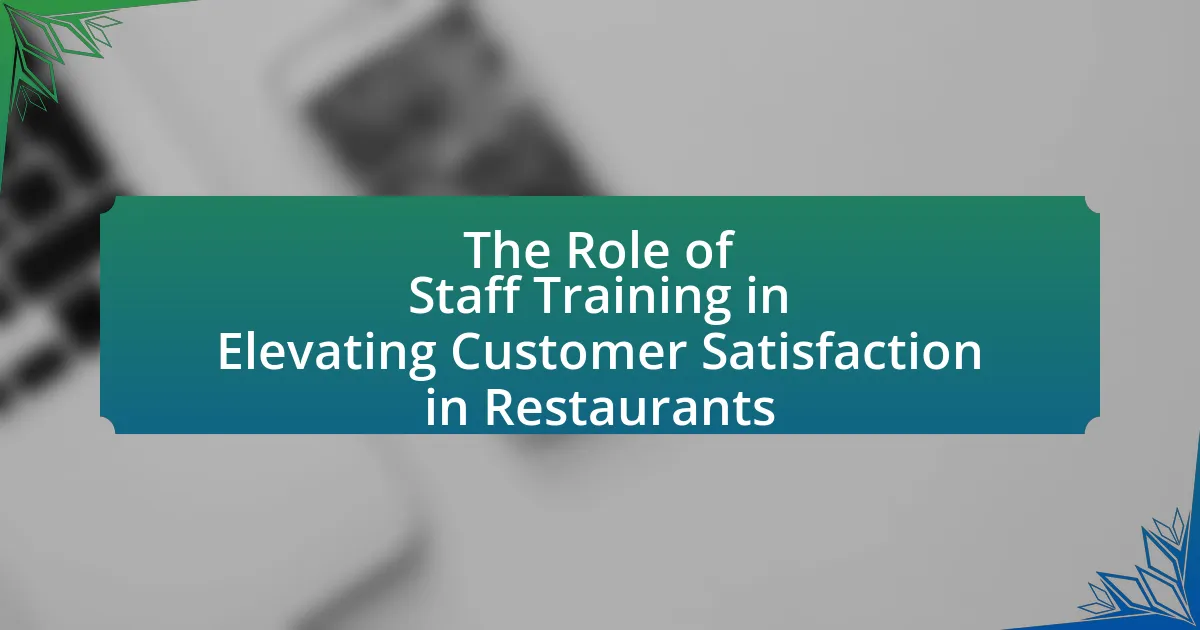The article focuses on the significance of restaurant layout design in enhancing customer experience. It explores how effective layout can optimize space utilization, improve customer flow, and create an inviting atmosphere, ultimately leading to increased satisfaction and revenue. Key elements discussed include the influence of layout on customer behavior, the importance of ambiance, and the various types of layouts that cater to different dining experiences. Additionally, the article highlights best practices for implementing layout changes, the role of technology in optimizing designs, and common mistakes to avoid, all aimed at improving overall customer satisfaction and operational efficiency in the restaurant industry.

What is the significance of restaurant layout design in enhancing customer experience?
Restaurant layout design significantly enhances customer experience by optimizing space utilization, improving flow, and creating an inviting atmosphere. A well-planned layout facilitates efficient movement for both customers and staff, reducing wait times and increasing satisfaction. For instance, research by the Cornell University School of Hotel Administration indicates that a thoughtful layout can lead to a 20% increase in customer turnover, directly impacting revenue. Additionally, elements such as seating arrangements and decor influence customer comfort and perception, contributing to a memorable dining experience.
How does restaurant layout influence customer behavior?
Restaurant layout significantly influences customer behavior by affecting their movement, comfort, and overall dining experience. A well-designed layout can enhance customer flow, reduce wait times, and create a welcoming atmosphere, which encourages longer stays and increased spending. For instance, research indicates that open layouts promote social interaction and can lead to higher customer satisfaction, while strategically placed seating can optimize privacy and comfort, impacting customers’ willingness to return. Additionally, studies show that the arrangement of tables and pathways can guide customers toward high-margin areas, such as bars or dessert displays, ultimately influencing purchasing decisions.
What are the key elements of effective restaurant layout design?
The key elements of effective restaurant layout design include flow, zoning, and visibility. Flow refers to the movement of customers and staff throughout the space, ensuring efficient service and minimizing congestion. Zoning involves creating distinct areas for dining, waiting, and service, which enhances the dining experience by providing comfort and organization. Visibility is crucial for both customers and staff, as it allows for easy navigation and enhances the overall ambiance. Research indicates that a well-planned layout can increase customer satisfaction and operational efficiency, ultimately leading to higher revenue.
How does layout affect customer flow and seating arrangements?
Layout significantly affects customer flow and seating arrangements by influencing how patrons navigate the space and interact with the environment. A well-designed layout facilitates smooth movement, reducing congestion and wait times, which enhances the overall dining experience. For instance, research indicates that restaurants with open layouts encourage more natural traffic patterns, allowing customers to move freely between areas such as the entrance, dining space, and restrooms. Additionally, strategic placement of seating can optimize capacity while maintaining comfort; studies show that arrangements promoting social interaction, such as communal tables, can increase customer satisfaction and dwell time. Thus, effective layout design directly correlates with improved customer flow and seating efficiency, ultimately enhancing the dining experience.
Why is customer experience important in the restaurant industry?
Customer experience is crucial in the restaurant industry because it directly influences customer satisfaction, loyalty, and revenue. Positive experiences lead to repeat visits and word-of-mouth referrals, which are vital for a restaurant’s success. According to a study by the National Restaurant Association, 70% of customers say that a positive dining experience encourages them to return. Additionally, a survey by Deloitte found that restaurants with high customer satisfaction scores see a 10-15% increase in sales compared to their competitors. Thus, enhancing customer experience through effective restaurant layout design can significantly impact a restaurant’s performance and profitability.
What role does ambiance play in customer satisfaction?
Ambiance significantly influences customer satisfaction by shaping the overall dining experience. A well-designed ambiance, including lighting, music, and decor, creates a welcoming atmosphere that enhances comfort and enjoyment. Research indicates that 60% of customers consider ambiance a crucial factor in their dining experience, impacting their likelihood to return and recommend the restaurant. For instance, a study published in the Journal of Retailing found that pleasant ambient conditions can increase customer dwell time and spending, demonstrating the direct correlation between ambiance and customer satisfaction.
How can layout design contribute to a memorable dining experience?
Layout design significantly contributes to a memorable dining experience by influencing customer flow, comfort, and ambiance. A well-planned layout facilitates smooth movement, allowing guests to navigate the space easily, which enhances their overall satisfaction. For instance, research indicates that restaurants with open layouts can increase customer retention by up to 20% due to improved accessibility and visibility. Additionally, strategic placement of tables and seating arrangements can create intimate dining experiences or foster social interactions, catering to diverse customer preferences. Effective layout design also incorporates elements like lighting and decor, which can evoke specific moods and enhance the dining atmosphere, further solidifying the overall experience.

What are the different types of restaurant layouts?
The different types of restaurant layouts include the traditional layout, open layout, and hybrid layout. The traditional layout typically features a defined dining area with separate sections for dining and service, promoting a structured flow. The open layout encourages a more casual atmosphere, often integrating the kitchen and dining space, which enhances customer interaction and engagement. The hybrid layout combines elements of both traditional and open designs, allowing for flexibility in seating arrangements and service styles. Each layout type is designed to optimize customer experience by facilitating movement, enhancing ambiance, and improving service efficiency.
How do various layouts cater to different dining experiences?
Various layouts cater to different dining experiences by influencing customer interaction, ambiance, and service efficiency. For instance, open layouts promote social interaction and a lively atmosphere, making them ideal for casual dining and family restaurants. In contrast, private booths or segmented areas enhance intimacy and focus, suitable for fine dining or romantic settings. Research indicates that layout design significantly impacts customer satisfaction; a study published in the Journal of Hospitality and Tourism Research found that well-planned layouts can increase customer retention by up to 20%. Thus, the choice of layout directly affects the overall dining experience by aligning with the restaurant’s concept and target audience.
What are the advantages of open kitchen layouts?
Open kitchen layouts enhance customer experience by fostering transparency and engagement between chefs and diners. This design allows patrons to observe food preparation, which can increase their trust in the quality and freshness of the meals being served. Research indicates that open kitchens can lead to higher customer satisfaction, as they create a lively atmosphere and encourage interaction, making dining more enjoyable. Additionally, open layouts can improve communication among staff, leading to more efficient service, which is crucial in a restaurant setting.
How does a traditional dining layout differ from a fast-casual setup?
A traditional dining layout typically features table service with a formal arrangement of tables and chairs, while a fast-casual setup emphasizes a more casual, self-service model with communal seating and quicker turnover. In traditional dining, customers are seated by staff and orders are taken at the table, promoting a leisurely dining experience. In contrast, fast-casual restaurants often have customers order at a counter and then find their own seating, which facilitates faster service and a more relaxed atmosphere. This difference in layout and service style directly impacts customer experience, as traditional dining focuses on an extended meal duration, whereas fast-casual dining prioritizes efficiency and convenience.
What factors should be considered when designing a restaurant layout?
When designing a restaurant layout, key factors include customer flow, seating arrangement, kitchen placement, and ambiance. Customer flow ensures efficient movement from entry to seating and service areas, minimizing congestion. The seating arrangement should balance comfort and capacity, accommodating various group sizes while maintaining an inviting atmosphere. Kitchen placement is crucial for operational efficiency, allowing staff to serve food quickly and effectively. Ambiance, influenced by lighting, decor, and layout, significantly impacts the dining experience, as studies show that a well-designed environment can enhance customer satisfaction and retention.
How do space constraints impact layout design?
Space constraints significantly impact layout design by limiting the arrangement and functionality of elements within a space. In restaurant design, these constraints necessitate careful planning to optimize seating capacity, circulation paths, and service areas, ensuring that the dining experience remains efficient and comfortable. For instance, a study by the National Restaurant Association indicates that effective space utilization can increase customer turnover rates by up to 20%, demonstrating the importance of strategic layout planning in maximizing both space and customer satisfaction.
What is the importance of accessibility in restaurant layout?
Accessibility in restaurant layout is crucial for ensuring that all customers, including those with disabilities, can navigate the space comfortably and safely. A well-designed layout that prioritizes accessibility can enhance the overall dining experience, leading to increased customer satisfaction and loyalty. According to the Americans with Disabilities Act (ADA), restaurants must provide accessible entrances, seating, and restrooms, which not only comply with legal standards but also expand the customer base by accommodating individuals with mobility challenges. Research indicates that businesses that prioritize accessibility can see a significant increase in patronage, as approximately 20% of the U.S. population has some form of disability. Thus, incorporating accessibility into restaurant design is not only a legal obligation but also a strategic advantage that fosters inclusivity and improves customer experience.

How can technology enhance restaurant layout design?
Technology can enhance restaurant layout design by utilizing data analytics and 3D modeling software to optimize space and improve customer flow. Data analytics allows restaurant owners to analyze customer behavior and preferences, leading to informed decisions about seating arrangements and service areas. For instance, a study by the National Restaurant Association found that restaurants using data-driven insights can increase efficiency by up to 20%. Additionally, 3D modeling software enables designers to visualize layouts in a virtual environment, allowing for adjustments before implementation, which can reduce costly redesigns. This integration of technology ultimately leads to a more efficient and customer-friendly dining experience.
What role does digital mapping play in optimizing restaurant layouts?
Digital mapping plays a crucial role in optimizing restaurant layouts by providing precise spatial analysis and visualization of the dining space. This technology allows restaurant owners to analyze customer flow, seating arrangements, and operational efficiency, leading to informed decisions that enhance both customer experience and staff productivity. For instance, studies have shown that effective layout design can increase customer satisfaction by up to 20% by minimizing wait times and improving accessibility. Additionally, digital mapping tools can simulate various layout scenarios, enabling restaurants to identify the most effective configurations for maximizing space utilization and improving overall service delivery.
How can customer feedback be integrated into layout design improvements?
Customer feedback can be integrated into layout design improvements by systematically collecting and analyzing customer insights to inform design decisions. This process involves utilizing surveys, comment cards, and digital feedback tools to gather specific information about customer preferences and pain points regarding the restaurant layout. For instance, a study by the Cornell University School of Hotel Administration found that restaurants that actively sought and implemented customer feedback saw a 15% increase in customer satisfaction scores. By prioritizing areas highlighted by customers, such as seating arrangements or flow of movement, restaurants can make targeted adjustments that enhance the overall dining experience.
What technologies can assist in analyzing customer flow and preferences?
Technologies that can assist in analyzing customer flow and preferences include heat mapping software, customer relationship management (CRM) systems, and data analytics platforms. Heat mapping software, such as Hotjar or Crazy Egg, visually represents customer movement within a space, allowing businesses to identify high-traffic areas and optimize layout accordingly. CRM systems, like Salesforce or HubSpot, collect and analyze customer data, providing insights into preferences and behaviors that can inform design decisions. Data analytics platforms, such as Google Analytics, track customer interactions and engagement, enabling restaurants to understand trends and make data-driven improvements to enhance the customer experience.
What are best practices for implementing effective restaurant layout design?
Effective restaurant layout design should prioritize customer flow, comfort, and operational efficiency. To achieve this, restaurants should create distinct zones for dining, waiting, and service, ensuring that pathways are clear and accessible. Research indicates that a well-organized layout can increase customer satisfaction by up to 20%, as it minimizes wait times and enhances the dining experience. Additionally, incorporating flexible seating arrangements allows for adaptability to different group sizes, further improving customer comfort. Implementing these best practices not only enhances the overall dining experience but also optimizes staff efficiency and service speed.
How can restaurants test layout changes before full implementation?
Restaurants can test layout changes before full implementation by utilizing pilot programs or mock setups. These methods allow restaurants to simulate the new layout in a controlled environment, gathering feedback from staff and customers. For instance, a restaurant might create a temporary layout change during a slow service period or use a designated area to trial the new design. This approach enables the collection of data on customer flow, staff efficiency, and overall satisfaction, which can be analyzed to determine the effectiveness of the proposed changes. Studies have shown that testing layouts can lead to improved operational efficiency and enhanced customer experiences, as evidenced by a 2019 survey indicating that 70% of restaurants that tested layout changes reported increased customer satisfaction.
What common mistakes should be avoided in restaurant layout design?
Common mistakes to avoid in restaurant layout design include poor flow, inadequate space for staff and customers, and neglecting the dining experience. Poor flow disrupts service efficiency; for instance, a layout that forces servers to navigate around obstacles can slow down service and frustrate customers. Inadequate space can lead to overcrowding, making it uncomfortable for diners and hindering staff movement, which can negatively impact service quality. Additionally, neglecting the dining experience by failing to consider sightlines, acoustics, and ambiance can diminish customer satisfaction. Research indicates that a well-designed layout can enhance customer retention by up to 30%, emphasizing the importance of avoiding these common pitfalls.
What practical tips can enhance customer experience through layout design?
To enhance customer experience through layout design, prioritize creating an intuitive flow that guides customers seamlessly through the space. Effective layout design should include clear pathways, strategically placed seating, and designated areas for different activities, such as dining, waiting, and socializing. Research indicates that a well-organized layout can reduce customer frustration and increase satisfaction; for instance, a study by the Cornell University Food and Brand Lab found that customers are more likely to return to restaurants with layouts that facilitate easy navigation and comfort. Additionally, incorporating elements like natural light and comfortable seating can further improve the overall dining experience, as studies show that ambiance significantly influences customer perceptions and enjoyment.




